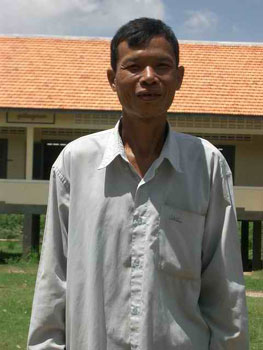The Cambodia Rural School Project
The O Svay Nippon
Foundation School

Neang Dao, the 53-year old director of the O Svay Nippon Foundation School.
Neang Dao is the 53-year old director of the O Svay Nippon Foundation School. He lives with his 48-year old wife Son Nath and has six children, all of whom attend a school closer to his home. He helps his family grow rice during school vacations.
“I live very far from the school, so it is hard getting to work everyday. I have to walk through the brush for about 1.5 hours, a distance of 7 kilometers, and canoe myself to work when it floods during the rainy season. This is extremely difficult, especially when there were strong winds and high waves.”
“I was born in the village of Onlung Koky in the Kang Meas district, Prek Koy commune. I moved to this village since 1984, when I was stationed as a teacher here.”
“I worked as a blacksmith during the Khmer Rouge regime, making things such as swords and knives and anything that contained metal. I did this for the entire time until the regime was overthrown in 1979.”
“I was educated at a Pedagogy school in Kang Meas district for three months starting December of 1992 until February of 1993. However, I had already begun teaching in this village since 1984. There was a tremendous lack of teachers after the Pol Pot regime so oftentimes people were just selected to become teachers. I became the school director in 2002, but was given the title since 2001.”
“I wanted to be a teacher because there were no teachers here at all, especially after the Khmer Rouge genocide. I felt sorry for the children because they had no one to educate them. I wanted to come here and become part of this rural community.”
“We’ve held about three award ceremonies for the children as of now. Prizes of pens and notebooks are given to those ranked 1-5. We’ll be having the ceremonies again soon, but not right now because it isn’t the end of the semester yet.”
“The old building had many, many problems. First of all, there were never enough desks or tables for the children to sit at. Many times they ended up sitting all along the sides of the classrooms on the floor beams or fought for seats. There were no walls, so we used coconut leaves as substitutions, but rain or the sun’s rays still crept in. There were lots of broken furniture, but everyone still just hung in there and kept on going.”
“The new building, on the other hand, keeps me completely contented. There are enough desks and chairs, and the windows can open and close just fine. There is enough room for the classes, and children no longer fight for seats (with a limit of two children per desk). It is a wonderful place for the children to receive their education.”
“There is currently somewhat of a lack of teachers, though, because many teachers don’t want to be stationed in this village, which is extremely poor and far from the city. Things have gotten a little bit better now because of the new dirt road, but it was impossible to travel here before. We also don’t have shelves for books yet, but I’m hoping that will change in the future.”
“I would like to thank the donors for constructing this school for us. You’ve helped us in more ways than you can imagine. I wish you good health and long lives. Thank you.”

